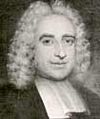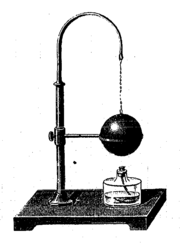- Willem 's Gravesande
-
Willem 's Gravesande 
Willem Jacob 's Gravesande (1688–1742)Born 26 September 1688
's-Hertogenbosch, NetherlandsDied 28 February 1742
Leiden, NetherlandsResidence Netherlands Nationality Netherlands Fields Philosopher and mathematician Institutions Leiden University Alma mater Leiden University Doctoral advisor John Theophilus Desaguliers
Herman BoerhaaveDoctoral students Pieter van Musschenbroek, Jean Allamand Known for Experimental proof of 
Influences Isaac Newton Influenced Émilie du Châtelet Willem Jacob 's Gravesande (26 September 1688 – 28 February 1742) was a Dutch philosopher and mathematician.
Contents
Life
Born in 's-Hertogenbosch, he studied law in Leiden and wrote a thesis on suicide. He was praised by John Bernoulli[1] when he published his book Essai de perspective. In 1715, he visited London and King George I. He became a member of the Royal Society. In 1717 he became professor in physics and astronomy in Leiden, and introduced the works of his friend Newton in the Netherlands. He opposed fatalists like Hobbes and Spinoza. In 1724, Peter the Great offered him a job in Saint Petersburg, but Willem Jacob did not accept.
His main work is Physices elementa mathematica, experimentis confirmata, sive introductio ad philosophiam Newtonianam or Mathematical Elements of Natural Philosophy, Confirm'd by Experiments (Leiden 1720), in which he laid the foundations for teaching physics. Voltaire and Albrecht von Haller were in his audience, Frederic the Great invited him in 1737 to come to Berlin.
His chief contribution to physics involved an experiment in which brass balls were dropped with varying velocity onto a soft clay surface. His results were that a ball with twice the velocity of another would leave an indentation four times as deep, that three times the velocity yielded nine times the depth, and so on. He shared these results with Émilie du Châtelet, who subsequently corrected Newton's formula E = mv to E = mv2. (Note that though we now add a factor of 1/2 to this formula to make it work with coherent systems of units, the formula as expressed is correct if you choose units to fit it.)
Works
- Essai de perspective, 1711
- Philosophiae Newtonianae Institutiones, in usus academicos, 1723
- An essay on perspective, 1724
- Physices elementa mathematica, experimentis confirmata, sive introductio ad philosophiam Newtonianam, 1720–1721
- Introductio ad Philosophiam, Metaphysicam et Logicam, 1736
- Mathematical Elements of Natural Philosophy, Confirm'd by Experiments: or, An introduction to Sir Isaac Newton's philosophy (Volume I), 1747
- Mathematical Elements of Natural Philosophy, Confirm'd by Experiments: or, An introduction to Sir Isaac Newton's philosophy (Volume II), 1747
- Oeuvres Philosophiques et Mathématiques de Mr. G. J. 'sGravesande, ed. with memoir by J. Allamand, 1774
References
- ^ Google Books Knight, C. (1841). Penny cyclopaedia of the Society for the Diffusion of Useful Knowledge, Volumes 21–22. Page 331. Retrieved 2009-10-06
- A.R. Hall, 's Gravesande, Willem Jacob, in Dictionary of scientific biography, vol. V; New York, 1972, p,. 509–11.
- C. de Pater, Experimental Physics, Leiden university in the seventeenth century. An exchange of learning, Leiden, 1975, p. 308–327.
External links
Categories:- 1688 births
- 1742 deaths
- Dutch physicists
- People from 's-Hertogenbosch
- Leiden University alumni
- Leiden University faculty
Wikimedia Foundation. 2010.

